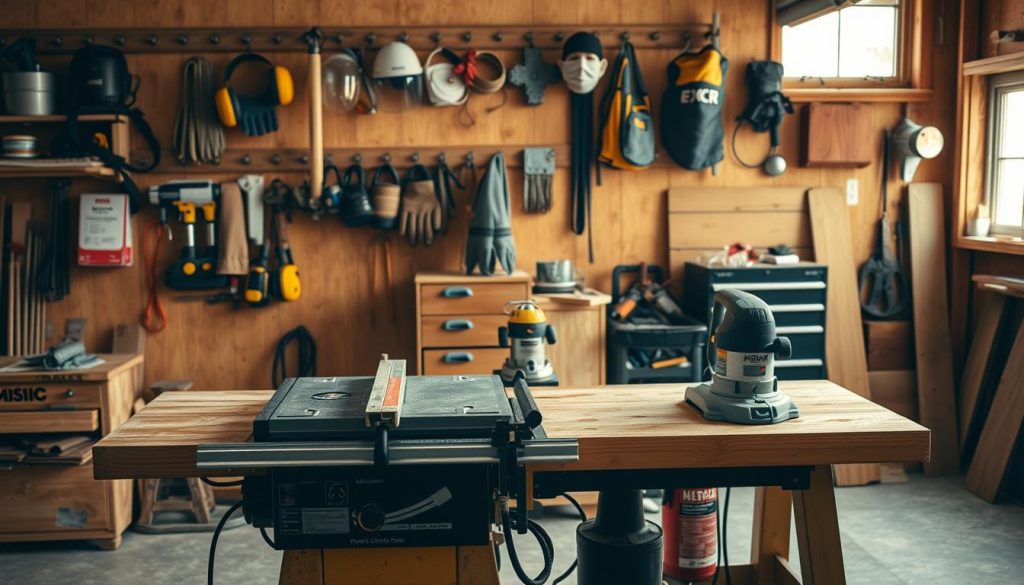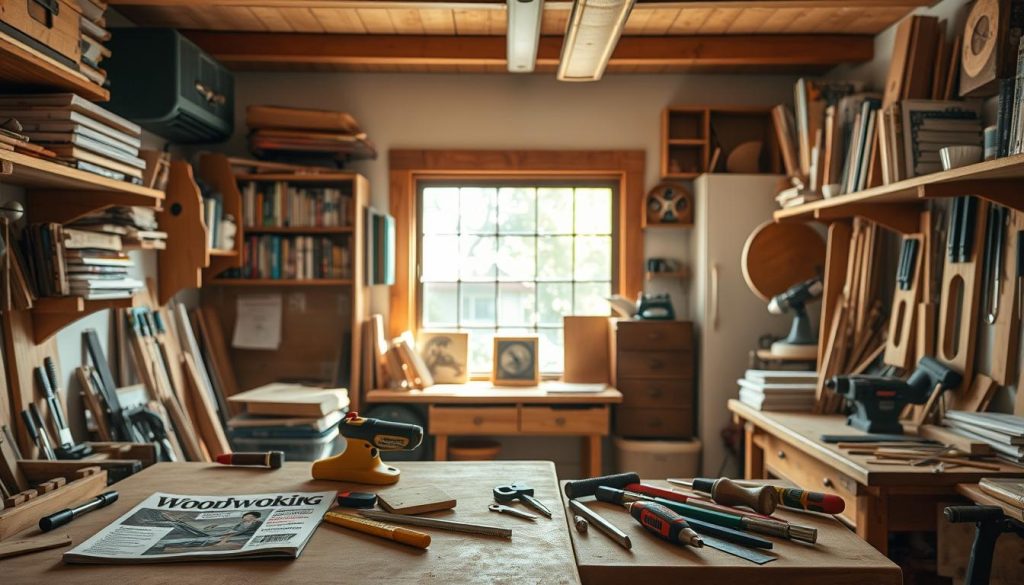Woodworking is a craft that turns simple wood into beautiful, useful items. This guide is for beginners, opening the door to DIY woodworking. Whether you want to make custom furniture or small decorations, you start with basic skills and a passion for it.
Learning woodworking tips can boost your confidence and teach you key techniques. Working with wood is not just about making things. It’s about feeling accomplished and creative, something few hobbies offer. You’ll learn about different woods and basic tools, making your woodworking journey rewarding and challenging.
Woodworking is more than just skill. It connects you to a craft that has been part of human creativity for thousands of years. With the right help and practice, anyone can turn raw wood into something amazing.
Key Takeaways
- Woodworking is accessible to everyone, regardless of experience
- Basic tools and techniques can be learned quickly
- Creativity and patience are your most important resources
- Safety should always be your first priority
- Start with simple projects to build confidence
What is Woodworking?
Woodworking is about making things from wood. It’s a mix of creativity, precision, and practical skills. It turns raw wood into useful and lovely items. Whether it’s a simple cutting board or complex furniture, it’s a fun journey for DIY fans.
Wood has been key in human history, used since ancient times. Early people made tools, weapons, and homes from wood. Woodworking shows how humans have always been inventive and problem-solvers.
A Journey Through Time
The history of woodworking is both interesting and deep. Ancient societies developed advanced woodworking methods. These methods are the base of today’s craftsmanship. Important moments include:
- Prehistoric tool-making using stone and wood
- Egyptian furniture construction techniques
- Medieval European woodworking guilds
- Industrial Revolution’s impact on woodworking tools
Woodworking in DIY Culture
Woodworking has grown from a need to a favorite hobby and creative space. Today, it lets people:
- Create custom furniture
- Fix household items
- Show their creativity
- Learn useful skills
For beginners, knowing woodworking’s history and role in culture is inspiring. It motivates you to begin your woodworking adventure.
Essential Tools for Beginners
Starting your woodworking journey requires the right tools. Whether you’re making a simple shelf or a custom piece of furniture, the right tools are key. They can make your project a success.
Creating a woodworking starter kit doesn’t have to be pricey or overwhelming. Choose versatile, quality tools that work well on many projects.
Must-Have Hand Tools
Every woodworking enthusiast needs a reliable set of hand tools. Here are the essentials:
- Hammer: For driving nails and general purpose work
- Measuring tape: Precision is key in woodworking
- Combination square: Ensures accurate angles and measurements
- Chisels: For carving and detailed work
- Hand saw: For manual cutting of wood pieces
- Screwdrivers: Both flathead and Phillips head
- Sandpaper: Various grits for smooth finishing
Basic Power Tools to Consider
As you get better at woodworking, think about adding these power tools to your starter kit:
- Cordless drill: Versatile and essential for most projects
- Circular saw: For straight cuts and larger wood pieces
- Random orbital sander: Creates smooth surfaces quickly
- Jigsaw: Great for curved and intricate cuts
You don’t need to buy everything at once. Start with basic tools and add more as you get better and tackle harder projects.
Choosing the Right Wood
Choosing the right wood is key for woodworking beginners. The wood you pick can make or break your project. It’s important to know about wood characteristics for success.
When you start woodworking, look for wood that’s forgiving and easy to work with. Different woods have unique qualities that affect your project’s look and durability.
Types of Wood for Beginners
- Pine: Soft, affordable, and readily available
- Cedar: Lightweight and naturally resistant to decay
- Poplar: Smooth and easy to cut and paint
- Oak: Durable and great for learning advanced techniques
Understanding Wood Grains and Finishes
Wood grain is important in woodworking for beginners. The wood fibers’ direction affects how well you can cut, sand, and finish. Always work with the grain for the best results.
- Straight grain: Easiest to work with
- Curly grain: More challenging for beginners
- Diagonal grain: Requires careful cutting
Choosing the right finish is important. It protects your wood and makes it look better. Beginners should start with simple finishes like clear polyurethane or wood oil.
Safety First: Woodworking Tips
Woodworking is a fun craft, but safety comes first. Beginners need to learn safety rules to avoid accidents and enjoy the craft.

Choosing the right safety gear is key. Beginners must protect themselves with the right equipment for every project.
Essential Safety Equipment
- Safety glasses or goggles to protect eyes from wood chips and dust
- Hearing protection when using loud power tools
- Dust masks or respirators to prevent wood particle inhalation
- Work gloves for hand protection
- Close-fitting clothing to prevent fabric catching in machinery
Workshop Safety Guidelines
- Keep your workspace clean and organized
- Ensure proper lighting in your work area
- Maintain sharp and well-maintained tools
- Disconnect power tools when not in use
- Never work under the influence of alcohol or medication
Following these tips, beginners can work safely and confidently. Remember, safety is as important as learning woodworking skills.
Planning Your First Project
Starting your woodworking journey can feel overwhelming. But, choosing the right beginner project makes all the difference. Woodworking projects for beginners should be simple, achievable, and build confidence in your emerging skills.
When selecting easy woodworking projects for beginners, focus on designs that require minimal tools and offer quick success. These initial projects help you develop fundamental skills without causing frustration.
Selecting Your First Woodworking Project
Consider starting with projects that match your current skill level and available tools. Some excellent options include:
- Simple wooden picture frame
- Basic wall-mounted shelf
- Small decorative box
- Rustic cutting board
Creating Your Project Cutting List
A detailed cutting list helps streamline your woodworking process. This essential planning step involves:
- Measuring required wood pieces precisely
- Listing exact dimensions for each component
- Identifying necessary wood types
- Calculating required material quantities
By carefully planning your project and breaking it into manageable steps, you’ll set yourself up for woodworking success. Remember, every expert woodworker started exactly where you are now – with their first simple project.
Techniques You Should Know
Learning beginner woodworking techniques is key for new woodworkers. Knowing the basics lets you make beautiful and useful projects with ease.
Basic Cutting Techniques
Woodworking for beginners begins with mastering basic cuts. You’ll need to know how to make crosscuts and rip cuts:
- Crosscut: Cutting across the wood grain, typically used to shorten board length
- Rip Cut: Cutting along the wood grain to adjust board width
Joinery Methods for Beginners
Creating strong wood connections is essential in woodworking. Here are some easy joinery techniques for beginners:
- Butt Joints: Simple connection where wood pieces meet at right angles
- Dado Joints: Creating grooves to connect wooden pieces securely
- Miter Joints: Angled cuts that create clean, precise corners
Sanding and Finishing Skills
Sanding is crucial for a smooth wood finish. Begin with coarse-grit sandpaper and move to finer grits for a glossy finish. Always sand with the wood grain to avoid scratches and get a smooth finish.
Setting Up Your Workspace
Creating a good woodworking space is key for beginners. You don’t need a huge area. Even a small space can be great with the right setup and organization.
When setting up your woodworking starter kit, think about these important things for your space:
- Choose a well-ventilated area with good lighting
- Ensure adequate electrical outlets for power tools
- Select a space with stable temperature and humidity
- Plan for potential dust collection systems
Organizing Your Tools
Good tool organization makes woodworking better. Get sturdy tool cabinets, wall-mounted pegboards, and tool chests. They help keep your tools easy to find and safe.
- Group similar tools together
- Use labeled storage containers
- Keep frequently used tools within easy reach
- Protect tools from moisture and dust
Creating a Comfortable Environment
A well-designed workspace makes you more productive and happy. Think about ergonomic things like workbench height, anti-fatigue mats, and good lighting. These help make your woodworking area comfortable.
- Install adjustable task lighting
- Use comfortable anti-fatigue floor mats
- Maintain comfortable room temperature
- Create dedicated zones for different woodworking activities
Learning Resources for Woodworkers
Starting your woodworking journey needs more than just passion and tools. Learning through various resources can turn a beginner into a skilled woodworker. Woodworking for beginners is not scary when you have the right help and materials.

Online Tutorials and Courses
Digital platforms have changed how we learn woodworking. Many top websites offer great beginner woodworking classes for all skill levels:
- Udemy: Offers video courses for woodworking beginners
- Skillshare: Has interactive workshops by professional woodworkers
- YouTube channels like Wood Whisperer and Paul Sellers
- Masterclass: Provides detailed woodworking tutorials by experts
Recommended Books for Beginners
Books are still key for learning woodworking techniques. Here are some essential books for woodworking fans:
- “The Essential Woodworker” by Robert Wearing
- “Complete Manual of Woodworking” by Albert Jackson
- “Understanding Wood” by R. Bruce Hoadley
- “Woodworking Basics – Mastering the Essentials” by Skills Institute Press
These resources give deep insights into woodworking, helping beginners gain confidence and skills. Whether you like online tutorials or books, there’s a great resource for your woodworking journey.
Woodworking Communities
Starting out in woodworking can seem daunting. But, joining woodworking communities can change everything. These groups offer support, inspiration, and tips that help you grow faster.
Discovering Local Woodworking Groups
Local woodworking groups are great for beginners. They meet in places like workshops and community centers. Here, members share:
- Technique demonstrations
- Tool recommendations
- Project collaboration
- Skill-sharing workshops
Leveraging Online Woodworking Networks
Online platforms have changed how woodworkers connect. Forums and social media groups offer quick access to advice and projects. Sites like Reddit, Facebook Groups, and woodworking forums help beginners:
- Ask technical questions
- Share project progress
- Get feedback
- Learn new techniques
By joining both local and online groups, beginners can learn faster, feel more confident, and make lasting connections.
Maintaining Your Tools and Workspace
Keeping your woodworking tools in good shape is key. They are an investment in your craft. Taking care of them means they last longer and work better. Cleaning, storing, and protecting your tools will help you get better results and save money.
For beginners, learning about tool care is important. Start by cleaning your tools after each use. Use a clean cloth to wipe down hand tools and remove dust. Apply a thin layer of machine oil to metal parts to stop rust.
Sharp tools are safer tools. So, spend time keeping your cutting edges sharp. Use sharpening stones or professional services to do this.
Keeping your workspace organized is also crucial. Set up specific spots for different tools. Use pegboards, wall racks, and toolboxes to keep things tidy. Make sure power tools are in protective cases and electrical gear is kept dry to avoid damage.
Make a routine for maintaining your tools. Check the sharpness of cutting edges, oil moving parts, and check power cords for damage. A well-kept workshop is safer and more fun. It lets your creativity shine.